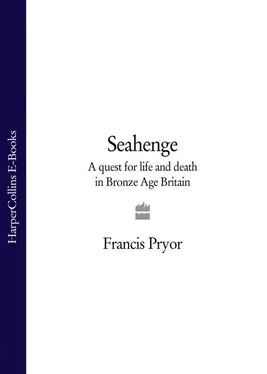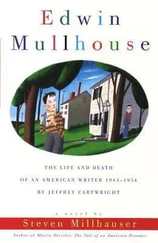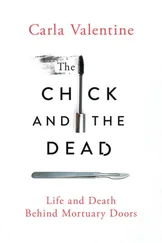SEAHENGE COMES HOME
The Seahenge excavations happened in 1999 and I wrote this book during the following year. While I was writing my wife Maisie Taylor would leave home every morning after breakfast, allowing me to do the washing-up, and would then drive the twenty-two miles to Flag Fen, where she would work away at the Seahenge timbers which were stored in tanks there. By this time, thank Heavens, the protestors and tabloid press had lost interest. After a few months, English heritage decided to have the timbers conserved by freeze-drying and when Maisie had finished with them they were taken to Wales where they were treated at the Mary Rose Trust’s laboratories. This process was completed early in 2007 and the timbers were then sent to King’s Lynn Museum, where money had been found for a permanent display in the main gallery. That display opened in February 2008 and it really is quite exceptionally good. Maisie and other archaeologists have been working with the design team closely and huge efforts have been made to get every possible detail correct. The new display gives a wonderful impression of what the site would have looked like in the Early Bronze Age, not on the beach, but in a damp and rather mysterious back-swamp behind the coastal dunes.
Scientific research has also been pressing ahead and, with admirable promptness, the full academic report appeared in 2003. * This report confirmed that the site was indeed constructed in the spring or early summer of the year 2049 BC. It also showed that Seahenge was far more complex than a simple timber circle. The central inverted tree was inserted first. Shortly afterwards a forked timber was placed to the south-west (towards the mid-winter setting sun). The forks formed a narrow gap or entrance into the planned circle. Next a screen of ten large timbers, all cut from the central tree, was placed directly opposite the fork, to the north-east. The ‘circle’ was then laid out in a series of ten straight or slightly curved panels. Within this arrangement were additional subtleties. Most of the posts had been driven into the ground with their bark facing away from the circle, like the trunk of a vast tree. But a few had been deliberately set the other way around. We don’t know why this was, but it seems to have been something that happened as part of the initial laying-out.
One of the biggest surprises came when Maisie studied the axe-marks on the timbers. She measured every single one and discovered that over fifty axes had been used – and this just a few centuries into the Bronze Age, when all believed that bronze was still scarce. If fifty axes had indeed been used, that probably means an absolute minimum of fifty people. Allow for friends and families, and the number of folk on that dune in north Norfolk would probably have been closer to two hundred and fifty. It would have been quite an occasion!
So last year the timbers came back home to Norfolk. The King’s Lynn Museum staff have finished the long job of preparing them for display. They also managed to raise money from the National Lottery and other donors to have a brand new gallery built to hold them. I’ve seen all the drawings and computer-generated images and it really is a superb recreation. It’s not just about accuracy; it’s also about atmosphere and what it would have felt like to have been just behind those coastal sand dunes in the early summer of 2049 BC. I am convinced that the people who built Seahenge would find its twenty-first century resting place respectful, yet mysterious – and welcoming.
Francis Pryor
July 2008
*Mark Brennand and Maisie Taylor, ‘The Survey and Excavation of a Bronze Age Timber Circle at Holme-next-the-Sea, Norfolk, 1998-9’ Proceedings of the Prehistoric Society , Vol.69, 2003, pp. 1-84
PROLOGUE John Lorimer’s Discovery
IT WAS EARLY SPRING, 1998, on the south side of the Wash in north-west Norfolk. John Lorimer and his brother-in-law Gary took the path through the pine woods, climbed up the dunes and stood at the top to catch their breath. The tide was now well on its way out, and the peat beds, which ran along the beach midway between high and low tide, were just beginning to be exposed. Between them John and Gary held a brand-new shrimping net, and today was to be its first outing. It was home-made, but sturdy and built to last. They knew it would be futile to test the net until the tide had retreated beyond the peat beds, as only then would the seabed be smooth enough to allow them to drag it through the water, so they decided instead to go crabbing and to test the net in an hour or so. At least that way they’d have something to take home for tea.
Just beyond the beach, behind a coastal barrier of dunes, was Holme-next-the-Sea Nature Reserve. It was a land of birds and dunes, of thin wiry grasses, orchids and Scots pines. And then of course there was the wind. It was always with you at Holme. Sometimes you thought it had dropped entirely, and that the air was truly still. Then you looked at the ground and saw that the blades of grass had never stopped nodding. It was as if someone had just left the room and had shut the door firmly behind them. There were little swirling drafts – not wind, not even a light breeze. Other times, when the weather came from off the Wash, the gales tore at the dunes with a destructive force that even a modern army couldn’t match. Coastal defences were ripped up. I have seen the aftermath of a fierce storm, when wire, fencing, young trees and posts had been hurled inland. In just two hours, a whole summer’s patient dunes-conservation programme could be reduced to a useless, tangled mess.
The Nature Reserve Warden, Gary Hibberd, and his wife Alison lived in The Firs, a large, late-Victorian house that had been built as part of a speculative venture which never got off the ground sometime around the turn of the century. One of the ground-floor rooms had been converted into a small shop and Visitor Centre, and Gary would chalk up a list of rare birds that could currently be seen in the reserve.
The pine trees that were presumably planted when The Firs was built covered the dunes between the house and the beach. They were mainly Corsican pines, a more vigorous species than our native Scots pine and better able to cope with the fierce conditions of this coast. They grew particularly well along the Holme dunes.
John and Gary knew that the best crabs were to be found lurking in dark nooks and crannies below the shelves of peat. John was walking in the shallow water along the edge of the peat. Before he’d even bent down to feel for a crab, his eye was suddenly taken by something green and metallic in the mud. Without thinking, he picked it up and turned it over in his hands. It wasn’t iron, he knew that. Was it brass? Probably. In which case it could have been a fitting – perhaps part of a porthole, or something from off the bridge – from the old wreck behind him, which he could see was just beginning to emerge from the waves. Still, he thought, it doesn’t exactly look brassy. He had seen pieces off wrecks before, and somehow this wasn’t right: it was more coppery, and with a strange, red-gold surface sheen.
Gary saw John standing slightly bent forward, with furrowed brows, turning the thing over and over in his hands, and wandered across to see what he’d found. John was always collecting things from off the beach. He was a regular jackdaw. His house a few miles away at North Creek was stuffed full of treasures: shells, blanched bones, driftwood, weird-shaped stones, pieces from wrecks. If he found anything attractive, John would want to take it home.
Gary looked at the piece of metal, shook his head and agreed it was probably something from the wreck. But they had work to do, so they thought no more about it. True to his jackdaw instincts, John slipped it into his back pocket. By now the tide had retreated well beyond the peat, and the timbers of the wreck were fully visible, surrounded by huge expanses of smooth, damp sand. Together John and Gary carried the net out into the shallow water, just above knee-depth. Then they tested it. It worked. In fact it worked well, and is in regular use to this day.
Читать дальше












